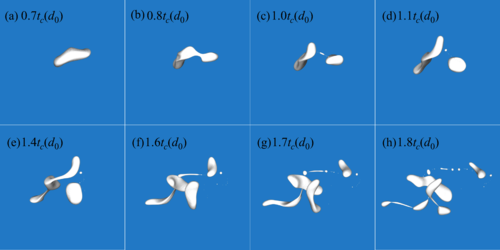
Aliénor Rivière, Daniel J. Ruth, Wouter Mostert, Luc Deike, and Stéphane Perrard
Phys. Rev. Fluids 7, 083602 – Published 30 August 2022: article link
The bubble size distribution below a breaking wave is of paramount interest when quantifying mass exchanges between the atmosphere and oceans. Mass fluxes at the interface are driven by bubbles that are small compared with the Hinze scale dh, the critical size below which bubbles are stable, even though individually these are negligible in volume. Combining experimental and numerical approaches, we report a power-law scaling d^−3/2 for the small bubble size distribution, for sufficiently large separation of scales between the injection size and the Hinze scale. From an analysis of individual bubble breakups, we show that small bubbles are generated by capillary effects, and that their breakup time scales as d^3/2, which physically explains the sub-Hinze scaling observed.


